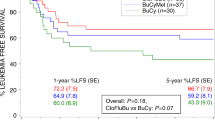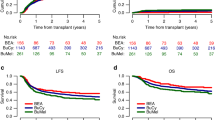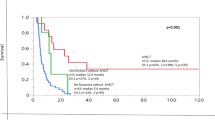Abstract
The optimal autologous stem cell rescue (HDC-SCR) regimen for children with high-risk neuroblastoma (HR-NBL) is not defined. Carboplatin/etoposide/melphalan (CEM) is the current US standard; however, European data suggest busulfan/melphalan (Bu/Mel) may have less toxicity. Published data regarding toxicities associated with CEM and Bu/Mel are limited. We conducted a single-institution retrospective cohort study of children with HR-NBL who received CEM or Bu/Mel preparative regimens. Toxicity data were analyzed using χ2 or Fisher’s exact, Wilcoxon two-sample or log-rank tests. Sinusoidal obstruction syndrome (SOS) was observed in 7/44 CEM (15.9%) and 5/21 (24%) Bu/Mel patients (P=0.50). Median time to SOS was longer following Bu/Mel than CEM (20 versus 9 days, P=0.02). Pulmonary hypertension (PHTN) was observed in ~20% of children after Bu/Mel and none after CEM (P=0.01). CEM patients had more nephrotoxicity (P=0.001), packed red blood cell (P=0.02) and platelet transfusions (P=0.008), and days on maximum pain support (P=0.0007). Time to engraftment, length of stay, documented infection rates and HDC-SCR-related mortality were similar. Nephrotoxicity and resource utilization associated with cytopenias and mucositis were greater after CEM. Pulmonary toxicities were more severe after Bu/Mel, and increased vigilance for PHTN may be warranted, particularly in children with hypoxemia out of proportion to respiratory distress.
This is a preview of subscription content, access via your institution
Access options
Subscribe to this journal
Receive 12 print issues and online access
$259.00 per year
only $21.58 per issue
Buy this article
- Purchase on Springer Link
- Instant access to full article PDF
Prices may be subject to local taxes which are calculated during checkout

Similar content being viewed by others
References
Matthay KK, Villablanca JG, Seeger RC, Stram DO, Harris RE, Ramsay NK et al. Treatment of high-risk neuroblastoma with intensive chemotherapy, radiotherapy, autologous bone marrow transplantation, and 13-cis-retinoic acid. Children's Cancer Group. N Engl J Med 1999; 341: 1165–1173.
Kreissman SG, Seeger RC, Matthay KK, London WB, Sposto R, Grupp SA et al. Purged versus non-purged peripheral blood stem-cell transplantation for high-risk neuroblastoma (COG A3973): a randomised phase 3 trial. Lancet Oncol 2013; 14: 999–1008.
Grupp SA, Stern JW, Bunin N, Nancarrow C, Ross AA, Mogul M et al. Tandem high-dose therapy in rapid sequence for children with high-risk neuroblastoma. J Clin Oncol 2000; 18: 2567–2575.
Seif AE, Naranjo A, Baker DL, Bunin NJ, Kletzel M, Kretschmar CS et al. A pilot study of tandem high-dose chemotherapy with stem cell rescue as consolidation for high-risk neuroblastoma: Children's Oncology Group study ANBL00P1. Bone Marrow Transplant 2013; 48: 947–952.
Valteau-Couanet D, Benhamou E, Vassal G, Stambouli F, Lapierre V, Couanet D et al. Consolidation with a busulfan-containing regimen followed by stem cell transplantation in infants with poor prognosis stage 4 neuroblastoma. Bone Marrow Transplant 2000; 25: 937–942.
Pasqualini C, Dufour C, Goma G, Raquin MA, Lapierre V, Valteau-Couanet D . Tandem high-dose chemotherapy with thiotepa and busulfan-melphalan and autologous stem cell transplantation in very high-risk neuroblastoma patients. Bone Marrow Transplant 2015; 51: 227–231.
Ladenstein RL, Poetschger U, Luksch R, Brock P, Castel V, Yaniv I et al. Busulphan-melphalan as a myeloablative therapy (MAT) for high-risk neuroblastoma: Results from the HR-NBL1/SIOPEN trial. J Clin Oncol 2011; 29: Abstract 2.
Ladenstein R, Potschger U, Hartman O, Pearson AD, Klingebiel T, Castel V et al. 28 years of high-dose therapy and SCT for neuroblastoma in Europe: lessons from more than 4000 procedures. Bone Marrow Transplant 2008; 41: S118–S127.
Hartmann O, Valteau-Couanet D, Vassal G, Lapierre V, Brugieres L, Delgado R et al. Prognostic factors in metastatic neuroblastoma in patients over 1 year of age treated with high-dose chemotherapy and stem cell transplantation: a multivariate analysis in 218 patients treated in a single institution. Bone Marrow Transplant 1999; 23: 789–795.
Veal GJ, Nguyen L, Paci A, Riggi M, Amiel M, Valteau-Couanet D et al. Busulfan pharmacokinetics following intravenous and oral dosing regimens in children receiving high-dose myeloablative chemotherapy for high-risk neuroblastoma as part of the HR-NBL-1/SIOPEN trial. Eur J Cancer 2012; 48: 3063–3072.
Dandoy CE, Hirsch R, Chima R, Davies SM, Jodele S . Pulmonary Hypertension after Hematopoietic Stem Cell Transplantation. Biol Blood Marrow Transplant 2013; 19: 1546–1556.
Kawashima N, Ikoma M, Sekiya Y, Narita A, Yoshida N, Matsumoto K et al. Successful treatment of pulmonary hypertension with beraprost and sildenafil after cord blood transplantation for infantile leukemia. Int J Hematol 2013; 97: 147–150.
Zeilhofer U, Ashworth M, Amrolia P, Rao A, Chiesa R, Veys P et al. Pulmonary hypertension following haematopoietic stem cell transplantation for primary haemophagocytic lymphohistiocytosis. Pediatr Blood Cancer 2013; 60: 521–523.
Ozyoruk D, Kibar AE, Surucu M, Azak E, Emir S, Cetin II et al. Pulmonary arterial hypertension in a child with stage-IV neuroblastoma after autologous hematopoietic stem cell transplantation and review of the literature. Pediatr Transplant 2015; 19: E185–E188.
Desai AV, Seif AE, Li Y, Getz K, Fisher BT, Huang V et al. Resource utilization and toxicities after carboplatin/etoposide/melphalan and busulfan/melphalan for autologous stem cell rescue in high-risk neuroblastoma using a national administrative database. Pediatr Blood Cancer 2016; 63: 901–907.
Children's Oncology Group. ANBL09P1: A COG Pilot Study of Intensive Induction Chemotherapy and 131I-MIBG Followed by Myeloablative Busulfan/Melphalan (Bu/Mel) for Newly Diagnosed High-Risk Neuroblastoma. Version 4A; 2013.
Children's Oncology Group. ANBL12P1: Pilot Study Using Myeloablative Busulfan/Melphalan (BuMel) Consolidation Following Induction Chemotherapy for Patients with Newly Diagnosed High-Risk Neuroblastoma. 2013.
Soni S, Pai V, Gross TG, Ranalli M . Busulfan and melphalan as consolidation therapy with autologous peripheral blood stem cell transplantation following Children's Oncology Group (COG) induction platform for high-risk neuroblastoma: early results from a single institution. Pediatr Transplant 2014; 18: 217–220.
Brodeur GM, Seeger RC, Barrett A, Berthold F, Castleberry RP, D'Angio G et al. International criteria for diagnosis, staging, and response to treatment in patients with neuroblastoma. J Clin Oncol 1988; 6: 1874–1881.
McDonald GB, Hinds MS, Fisher LD, Schoch HG, Wolford JL, Banaji M et al. Veno-occlusive disease of the liver and multiorgan failure after bone marrow transplantation: a cohort study of 355 patients. Ann Int Med 1993; 118: 255–267.
Jones RJ, Lee KS, Beschorner WE, Vogel VG, Grochow LB, Braine HG et al. Venoocclusive disease of the liver following bone marrow transplantation. Transplantation 1987; 44: 778–783.
Park JR, Scott JR, Stewart CF, London WB, Naranjo A, Santana VM et al. Pilot induction regimen incorporating pharmacokinetically guided topotecan for treatment of newly diagnosed high-risk neuroblastoma: a Children's Oncology Group study. J Clin Oncol 2011; 29: 4351–4357.
Toh HC, McAfee SL, Sackstein R, Cox BF, Colby C, Spitzer TR . Late onset veno-occlusive disease following high-dose chemotherapy and stem cell transplantation. Bone Marrow Transplant 1999; 24: 891–895.
Carreras E, Rosinol L, Terol MJ, Alegre A, de Arriba F, Garcia-Larana J et al. Veno-occlusive disease of the liver after high-dose cytoreductive therapy with busulfan and melphalan for autologous blood stem cell transplantation in multiple myeloma patients. Biol Blood Marrow Transplant 2007; 13: 1448–1454.
Acknowledgements
This study was supported by an Alex’s Lemonade Stand Foundation Center of Excellence Grant (Developmental Therapeutics Scholar, AVD) and an American Cancer Society Mentored Research Scientist Grant in Applied and Clinical Research, Grant number: MRSG-12-215-01-LIB (AES).
Author information
Authors and Affiliations
Corresponding author
Ethics declarations
Competing interests
The authors declare no conflict of interest.
Additional information
Supplementary Information accompanies this paper on Bone Marrow Transplantation website
Rights and permissions
About this article
Cite this article
Desai, A., Heneghan, M., Li, Y. et al. Toxicities of busulfan/melphalan versus carboplatin/etoposide/melphalan for high-dose chemotherapy with stem cell rescue for high-risk neuroblastoma. Bone Marrow Transplant 51, 1204–1210 (2016). https://doi.org/10.1038/bmt.2016.84
Received:
Revised:
Accepted:
Published:
Issue Date:
DOI: https://doi.org/10.1038/bmt.2016.84
This article is cited by
-
High-dose thiotepa, in conjunction with melphalan, followed by autologous hematopoietic stem cell transplantation in patients with pediatric solid tumors, including brain tumors
Bone Marrow Transplantation (2023)
-
Tandem high-dose chemotherapy with topotecan–thiotepa–carboplatin and melphalan–etoposide–carboplatin regimens for pediatric high-risk brain tumors
International Journal of Clinical Oncology (2019)
-
Long-term outcomes of the GPOH NB97 trial for children with high-risk neuroblastoma comparing high-dose chemotherapy with autologous stem cell transplantation and oral chemotherapy as consolidation
British Journal of Cancer (2018)
-
High-dose Carboplatin/Etoposide/Melphalan increases risk of thrombotic microangiopathy and organ injury after autologous stem cell transplantation in patients with neuroblastoma
Bone Marrow Transplantation (2018)
-
Antineoplastics
Reactions Weekly (2016)



